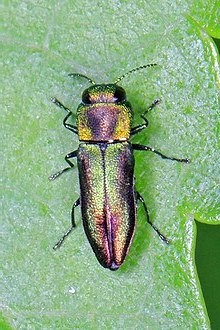Swiss jewel beetle
(Anthaxia helvetica)

Description
The Swiss jewel beetle (Anthaxia helvetica) belongs to a group of very similar looking small dark jewel beetles that are often found on yellow flowers and are sometimes grouped together as the "black species" of the genus Anthaxia. Like most jewel beetles, the species is specially protected by law under the Federal Species Protection Ordinance. The body is flat and wide. It is usually dark brown like the other "black species" of the genus, but there are also blue forms. The head is hidden in the pronotum almost to the posterior edge of the eyes. The eyes are oval and large. The feelers are eleven-membered, short and slightly serrate. They are hinged apart from each other near the front edge of the eyes. The forehead is relatively short and covered with dark brown hair, the hair running from the middle to the sides. The crown is relatively wide between the eyes, almost half as wide as the pronotum in front. The pronotum is almost rectangular, quite broad in comparison with similar species, about twice as wide as long. It is only slightly indented at the front edge and almost straight at the rear edge. Dimples may be indicated but are not as prominent as in the four-spotted jewel beetle (Anthaxia quadripunctata). On the disc of the pronotum there are a few elongated meshes between the longitudinal ribs. The rear angles of the pronotum are cut off and clearly indented. The elytra are uneven and densely punctured, clearly sculpted but without stripes or rows of dots. They are about one and a half times as long as they are wide. Their sides run parallel at the front, narrowing towards the tip. The edges turned down (epipleurae) widen from the middle to the tip. The shield is small, triangular and slightly wider than long. The anterior hip cavities are open behind. The spherical front hips are separated by a backward-pointing extension of the front breast. The hind hips have thigh covers. The tarsi are all five-membered. The claws are not split. Six sections (sternites) can be distinguished from below on the abdomen, the first two are broadly fused together in the middle. The middle and hind tibiae of the males are finely serrated, the females lack these perforations, and their bodies are somewhat stockier than those of the males.
Taxonomic tree:







